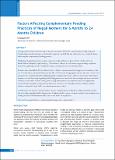Please use this identifier to cite or link to this item:
https://hdl.handle.net/20.500.14356/1858| Title: | Factors Affecting Complementary Feeding Practices of Nepali Mothers for 6 Months to 24 Months Children |
| Authors: | Chapagain, R H |
| Citation: | ChapagainR. (2013). Factors Affecting Complementary Feeding Practices of Nepali Mothers for 6 Months to 24 Months Children. Journal of Nepal Health Research Council. https://doi.org/10.33314/jnhrc.v0i0.392 |
| Issue Date: | 2013 |
| Publisher: | Nepal Health Research Council |
| Article Type: | Original Article |
| Series/Report no.: | May-Aug, 2013;392 |
| Abstract: | Abstract Background: Exclusive breastfeeding for the first six months followed by complementary feeding along with breastfeeding is crucial for proper growth and development of a child. The aim of the study was to study the factors influencing the complementary feeding practices. Methods: A hospital based cross-sectional study was conducted between June, 2010 to October, 2011, at Kanti Children’s Hospital, Nepal, involving1100 mothers of children 6 to 24 months of age attending outpatient department, applying systematic sampling technique and using semi-structured questionnaire. Results: More than half (56.81%) mothers fed their children complementary food of appropriate consistency; 366 (33.27%) fed with recommended frequency and 834 (75.82%) with the appropriate amount. But only 174 (15.82%) among all were actually feeding their child appropriate complementary food in sufficient amount and with required frequency. Lack of knowledge regarding ideal feeding practice was found to be the most important factor associated. Whether or not mother received feeding advice during immunization of the child was found to be significantly associated with appropriate feeding practice. Education of mother, type of family, profession of father, whether mother is a housewife or job holder was other important associations. Conclusions: Vast majority of Nepali mothers are not complementary feeding their child appropriately and they lack knowledge regarding ideal feeding practices. Emphasis should be given to educate mothers about complementary feeding practices and immunization clinics can be very useful for the purpose. |
| Description: | Original Article |
| URI: | http://103.69.126.140:8080/handle/20.500.14356/1858 |
| ISSN: | Print ISSN: 1727-5482; Online ISSN: 1999-6217 |
| Appears in Collections: | Vol. 11 No. 2 Issue 24 May - Aug, 2013 |
Files in This Item:
| File | Description | Size | Format | |
|---|---|---|---|---|
| 392-Article Text-439-1-10-20131127.pdf | Fulltext Download | 350.31 kB | Adobe PDF |  View/Open |
Items in DSpace are protected by copyright, with all rights reserved, unless otherwise indicated.
